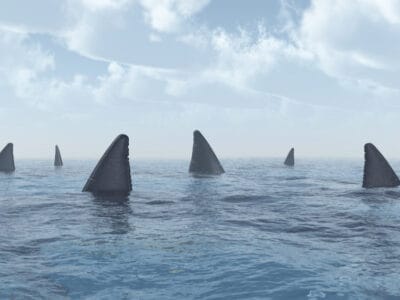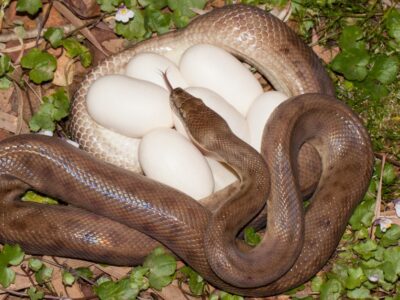Leatherback Sea Turtle
Dermochelys coriacea
They are the largest living turtle and the only sea turtle without a hard shell!
Advertisement
Leatherback Sea Turtle Scientific Classification
- Kingdom
- Animalia
- Phylum
- Chordata
- Class
- Reptilia
- Order
- Testudines
- Family
- Dermochelyidae
- Genus
- Dermochelys
- Scientific Name
- Dermochelys coriacea
Read our Complete Guide to Classification of Animals.
Leatherback Sea Turtle Conservation Status
Leatherback Sea Turtle Facts
- Prey
- jellyfish, sea squirts
- Main Prey
- Jellyfish
- Name Of Young
- eggs, hatchlings
- Group Behavior
- Solitary except during mating season
- Fun Fact
- They are the largest living turtle and the only sea turtle without a hard shell!
- Estimated Population Size
- less than 50,000
- Biggest Threat
- Humans, pollution, habitat loss, fishing vessel
- Most Distinctive Feature
- Leather-like skin
- Distinctive Feature
- Leather-like skin and massive size
- Other Name(s)
- Luth, leathery turtle, lute turtle, leatherbacks, leatherback turtle
- Gestation Period
- 2 months
- Litter Size
- 100
- Habitat
- moderate to tropical coastal ocean waters
- Predators
- Crabs, racoons
- Diet
- Omnivore
- Average Litter Size
- 100
- Type
- Reptile
- Common Name
- Leatherback Sea Turtle
- Location
- Oceans around the United States (including Hawaii ) , Puerto Rico , Indonesia , Africa
- Group
- Ridley
- Nesting Location
- Land
View all of the Leatherback Sea Turtle images!
The giant Leatherback Sea Turtle is the largest species of living turtle and one of seven species of sea turtles. Leatherback Sea Turtles do not have a hard shell and have been in their present shell-less form since dinosaurs were still in existence. Their dark gray skin is rubbery and strong, but also thin and very flexible. It has been difficult to study Leatherback Sea Turtles up close in the ocean because they do not maintain family units and spend a lot of time in waters too deep for human researchers to dive. Leatherback Sea Turtles are unique from other reptiles because they are not cold-blooded, meaning they have some ability to regulate their own body temperatures. This no doubt helps them when they are thousands of feet below sea level.
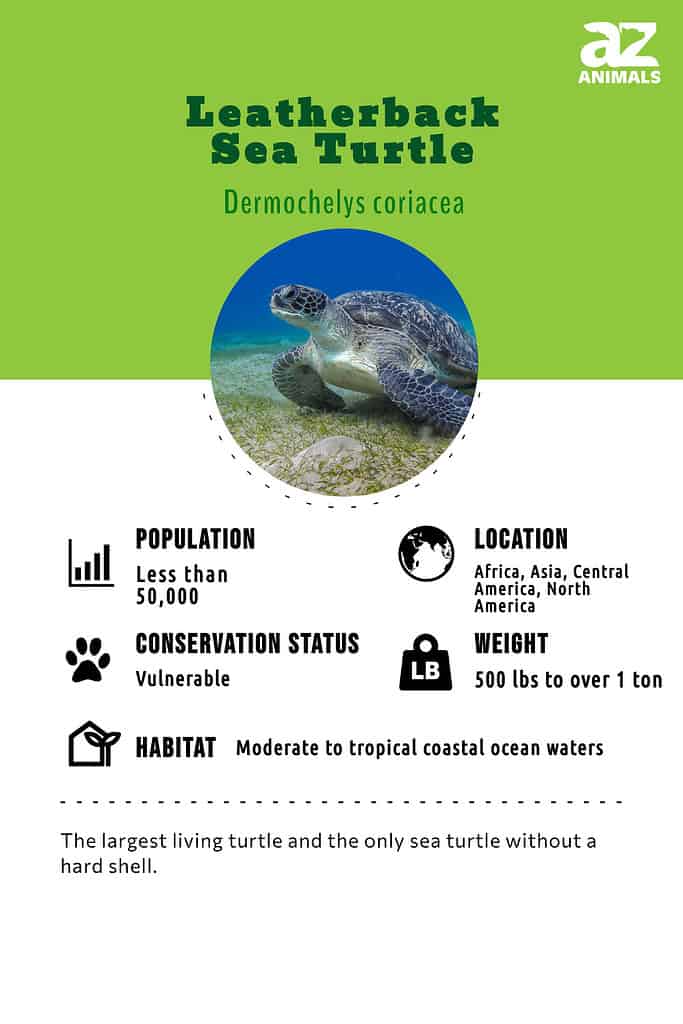
Six Amazing Leatherback Sea Turtle Facts!
- Leatherback Sea Turtles have been known to dive to depths of as much as 4000 feet!
- Female Leatherbacks typically return to the same nesting grounds every year, while males never leave the water once they enter it unless they are captured.
- Leatherback Sea Turtles are the largest living turtle species on the planet.
- The largest Leatherback Sea Turtle ever recorded was nearly 10 feet long and weighed over a ton!
- A Leatherback Sea Turtle may travel up to 10,000 miles in a single year.
- Leatherback Sea Turtles have a lifespan thought to be as long as 50 years.
Scientific name
The Scientific name of the Leatherback Sea Turtle is Dermochelys coriacea . They are also sometimes referred to as leatherbacks, leathery turtles, lutes( comparing the seven ridges that run along the turtle’s back to the strings of the instrument), or the luth. Dermochelys coriacea means “leathery turtle skin” though the exact translation is actually “skin turtle leathery.”
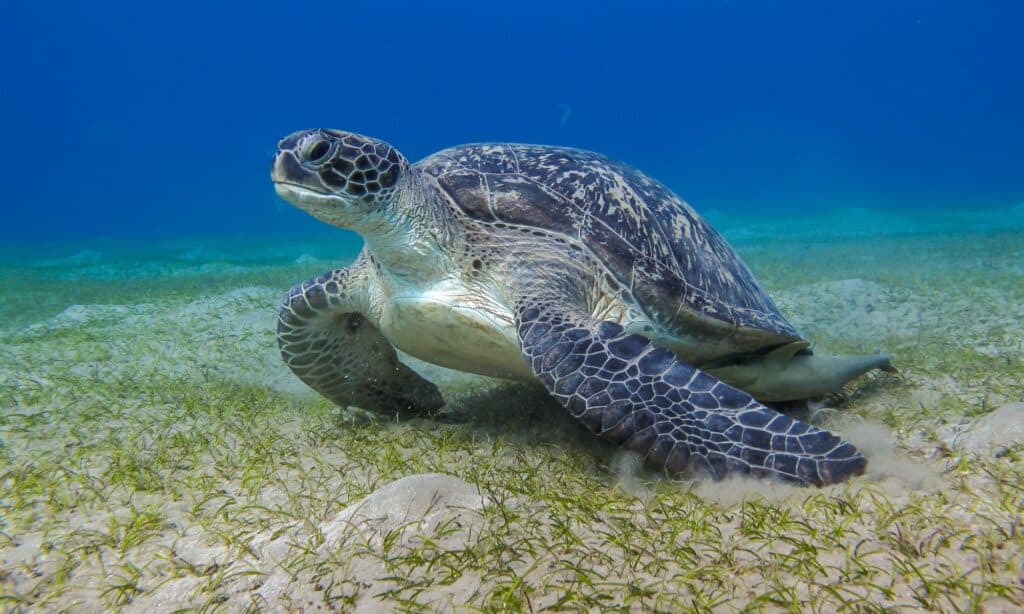
Leatherback Sea Turtles are the only species of sea turtle without a hard shell.
©iStock.com/YasserBadr_Beenthere
Species
The Leatherback Sea Turtle is the only species in the genus, Dermochelys, and is the only extant member of the family, Dermochelydae. The Leatherback Sea Turtle is a relative of the family Cheloniidae, which contains the other six extant sea turtles but also has a sister taxon of the extinct family, Protostegidae that included other species that did not have a hard carapace.
Evolution

Tortoises and Turtles evolved in South
Africa
, from a small reptile named
Eunotasaurus africanusaround 260 million years ago.
Turtles and tortoises evolved in South Africa around 260 million years ago, from a small reptile named Eunotasaurus africanus. This strange little lizard had the makings of modern-day turtles with thick, backward curving ribs that formed an armored dome under its skin.
A reptile called Odontochelys semitestacea evolved 40 million years later in the shallow oceans of China. The Odontochelys had one trait that modern turtles and tortoises share – a plastron or bottom shell. It is believed that these tortoise ancestors developed lower shells first because sharks and other predators attacked them from below the surface of the water.
Proganochelys, or “beast turtle” lived among the dinosaurs and was armored above and below. In addition to its protective shell, this ancient turtle had bony neck spikes, leg spikes, and tail spikes. Like its modern relatives, it had a bony shell and a toothless mouth.
These three turtle ancestors diverged into the terrapin, sea turtle, and tortoise we know today.
Appearance
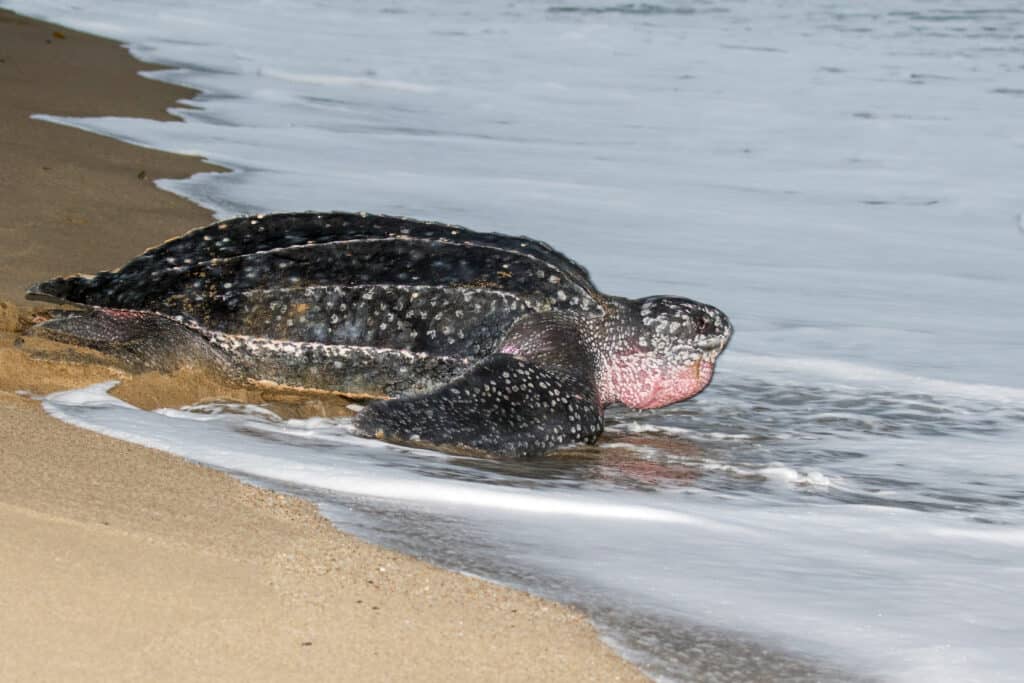
Leatherbacks have tough, rubbery medium blue-gray skin with ridges that look like strips of leather sewn together.
©iStock.com/AGAMI stock
The Leatherback Sea Turtle differs from all other sea turtles, in that it does not have a hard shell or scales. Instead, the Leatherback Sea Turtle has seven spiny vertical ridges made of bone where the shell would be on almost any other turtle, giving it’s back the appearance of strips of leather sewn together. A Leatherback’s tough rubbery skin is medium blue-gray to black, with minor pattern variations, including spots and stripes, and a whitish pink underbelly. Their front flippers reach slightly more than halfway down their bodies, while their back feet are very short, and their flippers do not have claws.
Behavior
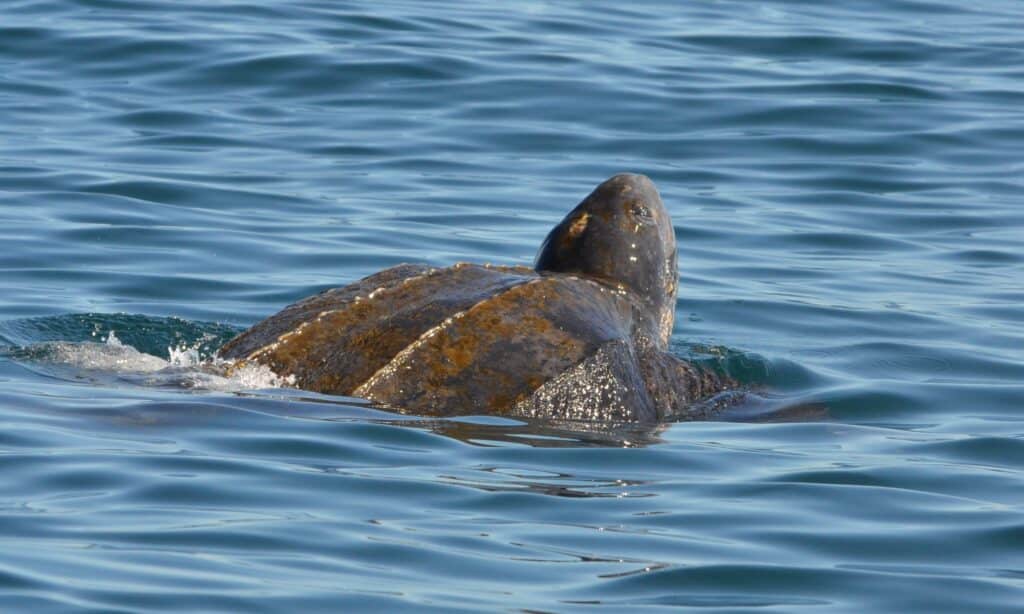
Leatherback Sea Turtles spend the majority of their lives underwater.
©iStock.com/jtstewartphoto
Leatherback Sea Turtles are solitary animals. They rarely interact with one another or come out of the sea, except during mating season and nesting. Leatherback Sea Turtles are one of the deepest diving marine animals that do not live in the depths. Though Leatherback Sea Turtle comes out of the water to lay their eggs on land, they spend the majority of their time thousands of feet underwater. They are not particularly aggressive, but if they feel threatened, they will bite. Unlucky humans who get bitten may sustain serious bruises or even broken bones because Leatherback Sea Turtles have sharp-beaked mouths and powerful jaw muscles, in keeping with their giant size.
Habitat

Approximately the middle third of the globe – consisting of tropical waters – is the habitat of the Leatherback Sea Turtle.
©Bob Pool/Shutterstock.com
The Leatherback Sea Turtle can be found in the tropical and temperate ocean waters on both sides of the United States, including Hawaii, and also places like Puerto Rico, the Virgin Islands, and other parts of Indonesia, and Africa. Approximately the middle third of the globe is the Leatherback Sea Turtle habitat. Their territory ranges from on land during mating season down to depths of 4000 feet when they dive.
Diet
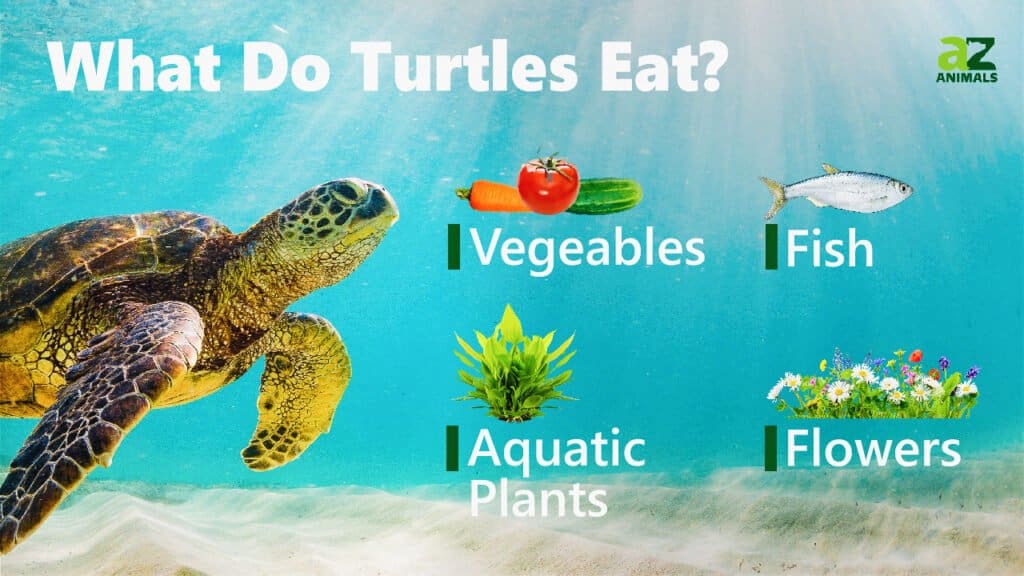
The mouth of the giant Leatherback Sea Turtle is not capable of chewing prey with hard bodies. Because of this, the Leatherback Sea Turtle’s diet consists primarily of jellyfish, sea squirts, and other invertebrates. Leatherback Sea Turtles are referred to as gelatinivores. Their mouths and throats have backward-facing spines, an adaptation that helps them eat gelatinous prey. Leatherback Sea Turtles can consume almost their own body weight in jellyfish in a single day.
Predators and Threats

Sadly, Leatherback Sea Turtles can mistake discarded plastic bags for jellyfish, causing them to get sick or die.
©Dmytro Flisak/Shutterstock.com
Adult Leatherback Sea Turtles have few natural predators due to their size and how deeply they can swim, though raccoons, crabs, and birds often feed on their eggs and young when left unattended. Unfortunately, Leatherback Sea Turtles still face many other threats to their lifespan and indeed the existence of their species, almost entirely from humans. Leatherback Sea Turtles are hunted by poachers and humans take their eggs. The Leatherbacks get sick or even die from eating human pollution in the form of fishing lines or plastic bags they mistake for jellyfish or just getting debris in their mouths. Leatherback Sea Turtles may even get caught in fishing nets. Climate change is also a factor in the declining numbers of Leatherback Sea Turtles, and there are instances of them being struck by marine vehicles. Because of this, they are listed as Vulnerable by the IUCN Red List. Conservation efforts to rescue their populations are underway and currently yielding promising results, but there is a lot of work to be done before they are out of danger, and they are at definite risk of extinction in the next few decades if things don’t improve.
Reproduction and Life Cycle
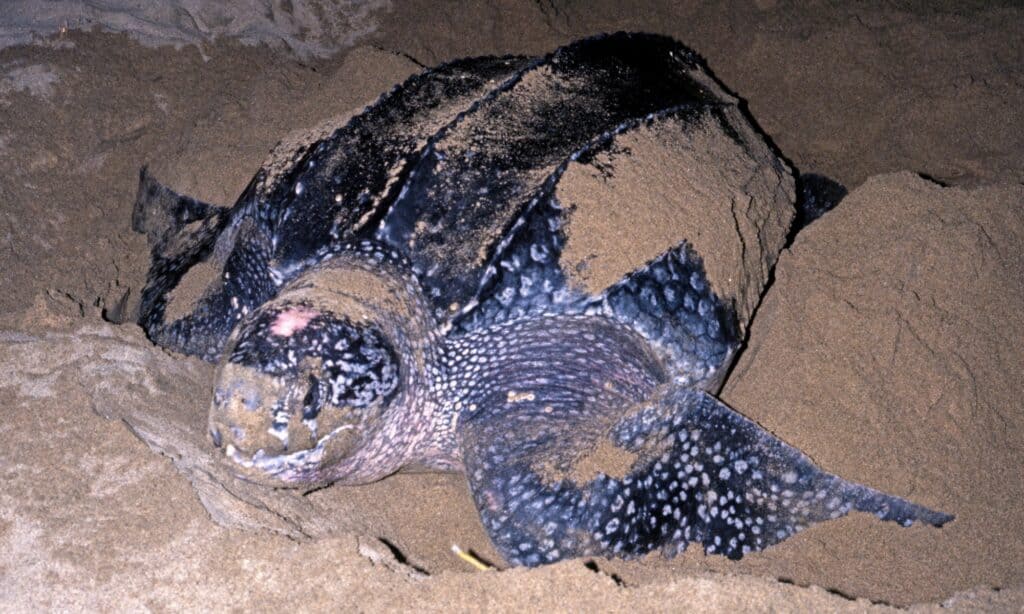
Female Leather-back sea turtles lay around 100 eggs in sand burrows every eight to 12 days for a short period – around 700 eggs per mating season.
©iStock.com/caronB
Scientists do not know exactly when a Leatherback Sea Turtle reaches the age of sexual maturity, but it is believed to be between the ages of nine and 20. The reason is it so hard to determine is because they are most easily studied on land, but once they hatch and enter the ocean, female Leatherback Sea Turtles only come out of the water to lay their eggs. Males do not leave the water at all.
Leatherback Sea Turtles do not lay their eggs every year either which may be partly responsible for their declining numbers. Leatherback Sea Turtles do however lay more than one clutch of eggs per nesting season. Every two to four years, a female Leatherback will come ashore to nest after mating and will lay eggs several times that season. She will lay approximately 100 eggs in sand burrows. She will do this every eight to 12 days for a short period, laying about four to seven clutches in total, or between 400 – 700 eggs per season. After two months of incubation, the eggs will hatch into hatchlings. Their journey from nest to sea is perhaps the most perilous part of a Leatherback Sea Turtle’s life, as this is when they are the most vulnerable to predators and poachers.
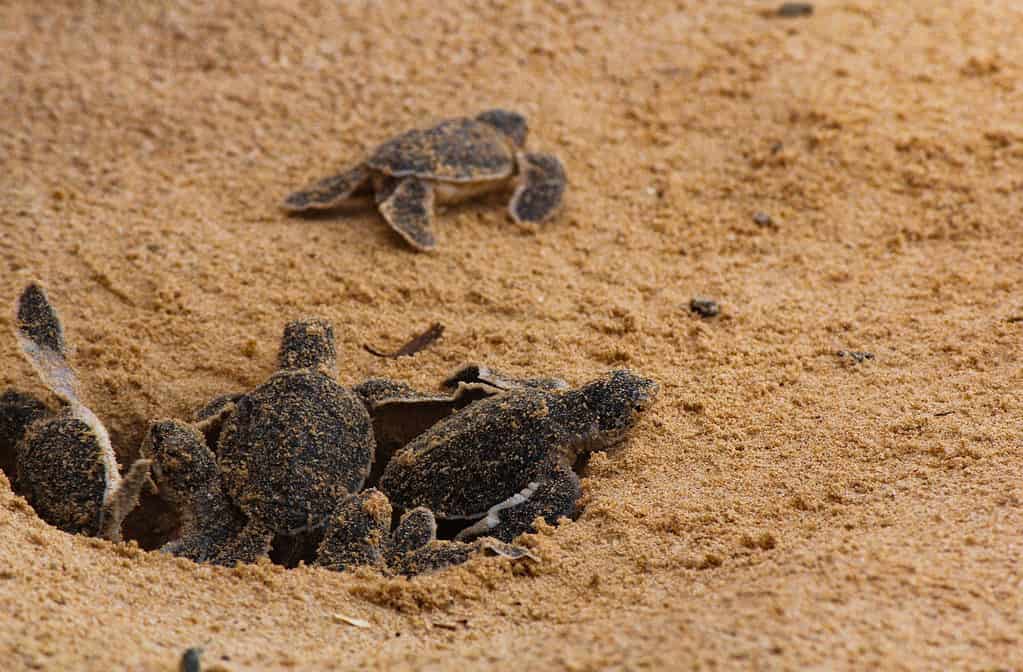
Baby sea turtles hatch after two months and leave the nest for the sea.
©SLSK Photography/Shutterstock.com
Population
Leatherback Sea Turtle numbers are in decline. In particular, the Pacific Ocean Leatherback Sea Turtle populations are declining and they are at risk for full extinction, with fewer than 3000 adult Leatherback females believed to be in existence in that area of the ocean. In 1980, there were over 100,000 female adults Leatherback Sea Turtles in all known areas thought to be in existence. At the most recent count, there were only around 25,000 – 35,000 female adults. Malaysian nesting grounds have completely disappeared, which is not a good sign. Nesting grounds in other places have severely declined, from thousands of nests down to only a handful per year.
The male population size of the Leatherback Sea Turtle is not known, but at least for the Pacific population, scientists worry that it will be below 1000 by 2030. It is harder to study the male Leatherback Sea Turtles because they do not leave the water during mating season as the females do, and population estimates are based on the fact that about 10 percent of hatchlings are male and 90 percent are females. So the male adult population is estimated to be about 10 percent that of the females.

Ecologists released tens of thousands of Leatherback Sea Turtle hatchlings into the ocean in 2020 and 2021.
©Julian Wiskemann/Shutterstock.com
There is good news, however. In 2020 and 2021, ecologists were able to successfully release tens of thousands of hatchlings into the ocean, and reduced egg poaching down to just a single percent of the total eggs. Keeping the hatchlings safe is paramount to ensuring the survival of the Leatherback Sea turtle species, so if these numbers are sustainable, it is possible that the Leatherback populations will once more be on the rise instead of the decline. Otherwise, Leatherback Sea Turtles face extinction within the next 20 years.
View all 103 animals that start with LLeatherback Sea Turtle FAQs (Frequently Asked Questions)
How many leatherback turtles are left?
eatherback Sea Turtles in existence, down from 110,000 in 1980.
Can leatherback turtles hurt you ?
While Leatherback Sea Turtles are not aggressive, if they feel threatened, they can and will bite a human with their powerful beak mouth, often leading to severe bruises or potentially breaking bones.
Why is the leatherback turtles going extinct?
The Leatherback Sea Turtle is in danger of going extinct because of habitat and nesting loss, human encroachment, poaching, getting caught in fishing nets, being hit by fishing boats and other marine vessels, and accidentally feeding on plastic bags and other trash in the ocean.
How many leatherback turtles are left in the world?
The exact numbers of male Leatherback Sea Turtles left in existence is not known because they do not leave the water during mating season like the females do, but it is estimated to be approximately 10 percent of the female population, or between 2500-3500.
How big is a leatherback sea turtle ?
A Leatherback Sea Turtle can vary in size from four to eight feet in length on average, with a weight between 500 and 2000 pounds.
What are the key differences between green sea turtles and leatherbacks?
The key differences between green sea turtles and leatherbacks are shell, size, appearance, distribution, diet, and conservation status.
Thank you for reading! Have some feedback for us? Contact the AZ Animals editorial team.
Sources
- Reptiles of Ecuardor
- NOAA Leatherback Sea Turtle Information
- Leatherback Sea Turtle Wiki Facts
- World Wildlife Federation Leatherback Sea Turtle Facts
- Information About Sea Turtles: Leatherback Sea Turtle
- National Wildlife Reptiles Sea Turtles Leatherback
- Biological Diversity: Saving the Leatherback Sea Turtle
- Leatherback Sea Turtle
- Snappy Creations: Do leatherback sea turtles ever bite?
- Endangered Leatherback Sea Turtles Off West Coast May Gain Critical Habitat Protections
- Biological Diversity Atlantic Leatherback Sea Turtle
- Oceana Giant Leatherback Sea Turtle
- See Turtles: Leatherback Sea Turtle Lifespan Turtle Facts & Tidbits
- FWS Factsheet: Leatherback Sea Turtle Male Populations
- How many male leatherback sea turtles are there left?
- Time is running out for embattled Pacific leatherback sea turtles
- Saving Leatherback Sea Turtles during the Pandemic
- How Many Sea Turtles Are Left? Species Breakdown
- Leatherback Sea Turtles may become Extinct within 20 Years: A Study












